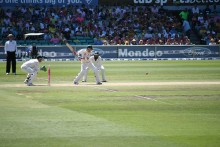
Law 6 of the governing laws of cricket states that the length of the bat should be no greater than 965mm (38 inches) and the width no more than 108mm (4.25 inches). Furthermore, all bats must be made of wood - following the "heavy metal" incident in 1979, during which Australian cricketer Dennis Lillee attempted to use an aluminum bat in a test match.
Variations in length, width and weight of cricket bats
The rules stipulating the size of a bat are only maximum restrictions and therefore manufacturers and players alike have striven to produce more innovative designs in an attempt to make more powerful bats. Different players have varying preferences for the size, balance and weight of bats and, as a result, there is a wide variety of cricket bats in production. However, the bats do all have the same basic design due to the size restrictions. In terms of other design considerations, there is no standard weight or weight restriction, and so players can choose the weight of their bats according to their own preference - although most bats tend to weigh between 1.1 to 1.4 kg (2lb 7 oz to 3lb). These days, most bats are manufactured in India or Pakistan and are made of English or Kashmiri Willow.